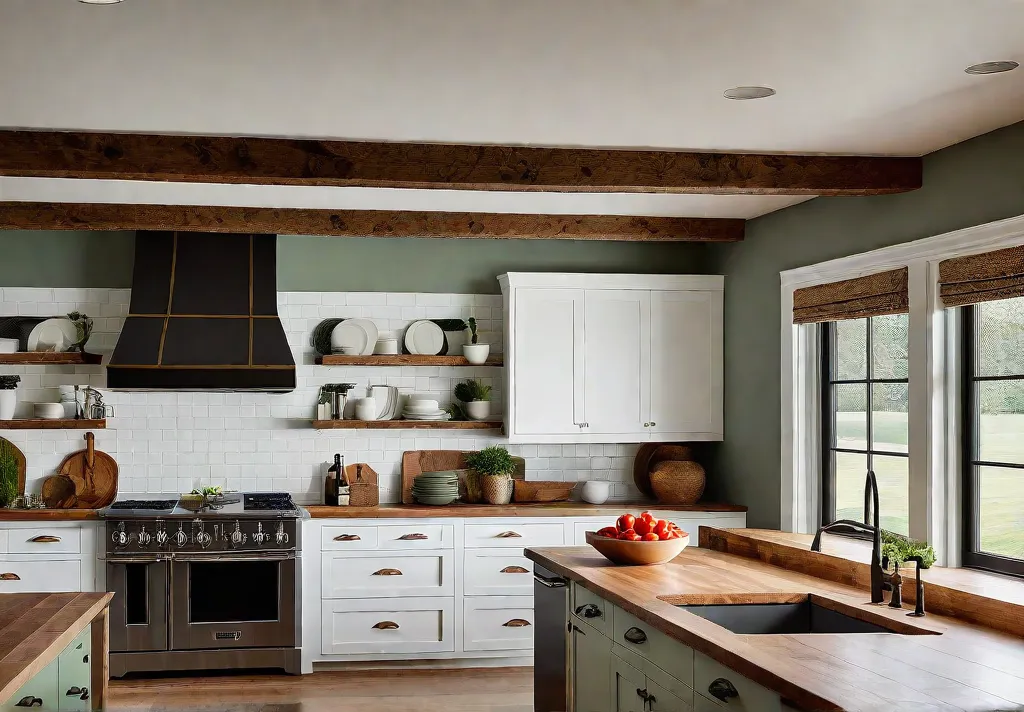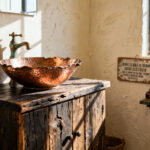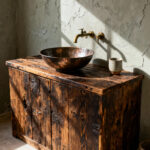Step into a farmhouse kitchen, which envelops you in a world of rustic charm and cozy comfort. These spaces make you feel at home like you’ve stumbled upon a treasured family heirloom. But what truly sets a farmhouse kitchen apart is the artful blend of elements that creates a warm, inviting atmosphere.
From the soothing palette of neutral hues that form the foundation to the rich wood tones that infuse depth and character, each aspect is carefully curated to evoke a sense of natural beauty. Pops of vibrant color add personality and liveliness, while textural elements like exposed brick and woven fabrics lend an irresistible rustic appeal.
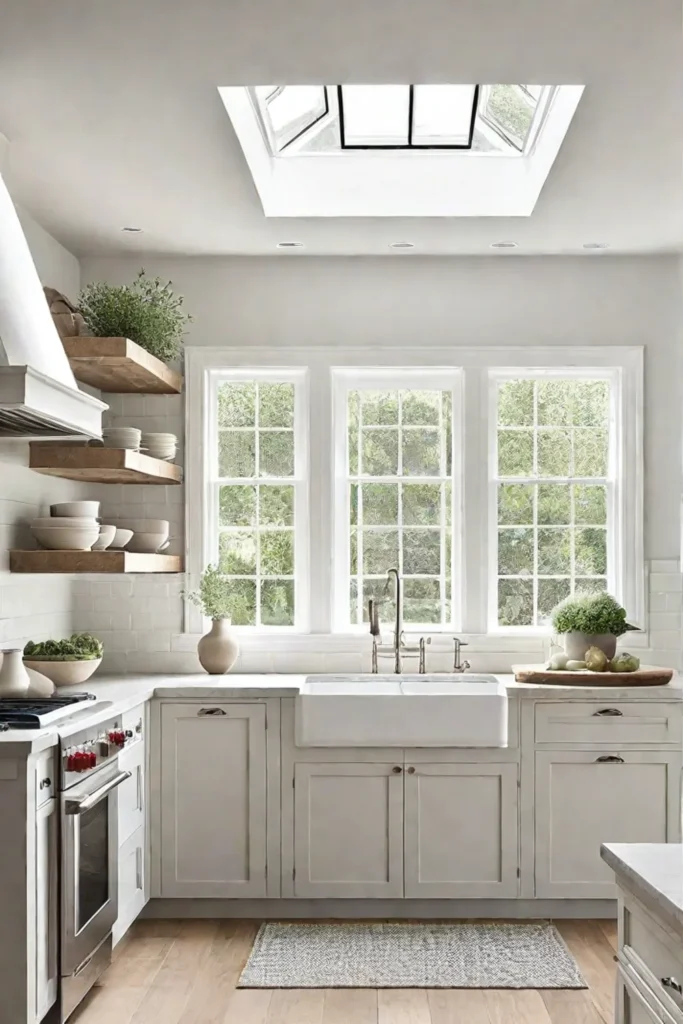
This harmonious interplay of colors, textures, and materials transforms a mere kitchen into a space that feels both timeless and uniquely yours. So, let’s embark on a journey to create a farmhouse kitchen that captures the essence of warmth, comfort, and understated elegance – a true haven where memories are made and traditions are celebrated.
The Allure of Neutral Farmhouse Colors
As the heart of the home, the kitchen should radiate warmth and comfort – and what better way to achieve this than with a soothing palette of neutral hues? Neutrals form the foundation of farmhouse color schemes, creating a calming and versatile backdrop that allows other elements to shine.
Choosing the Right Neutral
The beauty of neutrals lies in their ability to complement a wide range of styles and accents. The options are endless, from crisp whites to cozy creams, calming beiges to sophisticated grays, and the ever-versatile greige (a blend of gray and beige). When selecting your neutral canvas, consider the overall ambiance you wish to create. Whites and lighter tones lend an airy, bright feel, while deeper shades offer a cozier, more grounded vibe.
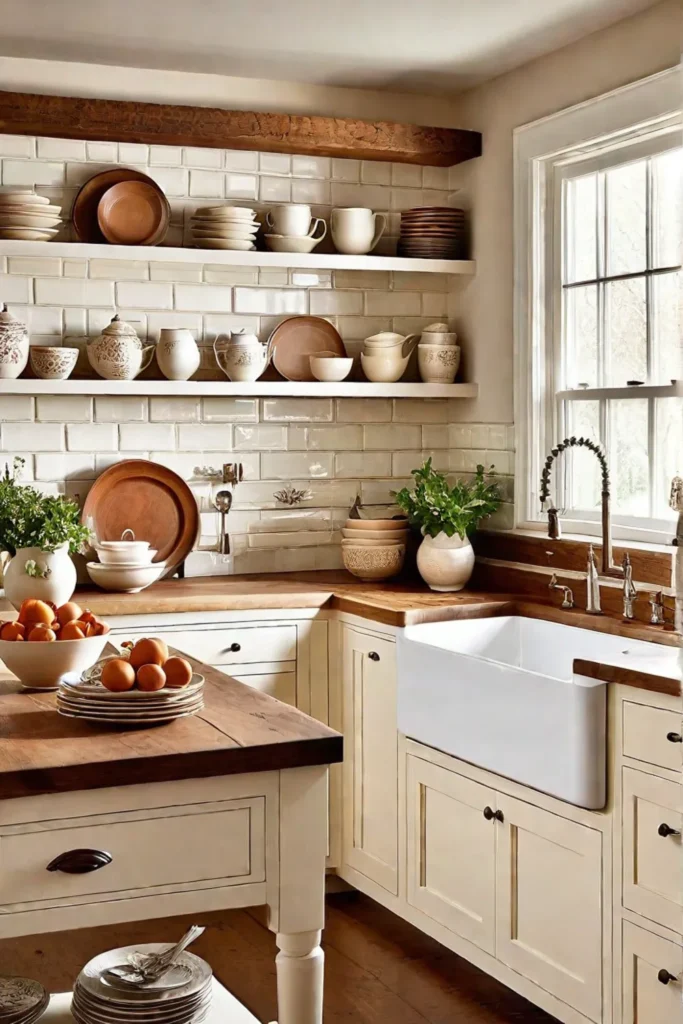
Balancing Warm and Cool Neutrals
The perfect balance between warm and cool neutrals is key to achieving a harmonious farmhouse aesthetic. Warm neutrals, such as beiges and creams, evoke a sense of rustic charm, while cooler grays and greiges provide a modern, refreshing contrast. Don’t be afraid to mix and match—a warm, creamy wall paired with cool gray cabinets can create stunning visual depth.
Layering Neutral Shades
Layer different shades of the same neutral throughout your kitchen to add depth and visual interest. For instance, you might pair creamy white walls with light gray cabinets and a beige backsplash. This subtle interplay of tones creates a cohesive yet dynamic space that feels inviting and sophisticated.
White in farmhouse kitchens has its roots in the practical need for cleanliness and light reflection in rural homes. Today, this timeless hue remains a staple, offering a fresh and airy canvas that truly allows the warmth of wood accents and pops of color to shine.

The psychological effects of different neutral colors can vary. Warm neutrals like beige and cream create a cozy, nurturing ambiance, while cooler grays and greiges can lend a sense of calm and sophistication. The amount of natural light in your kitchen also plays a role – spaces with ample sunlight may benefit from cooler tones to balance the warmth, while darker kitchens can be brightened with warmer neutrals.
Neutrals provide a timeless foundation for farmhouse kitchens, allowing you to create a space that feels both welcoming and stylish. By carefully selecting and layering these versatile hues, you can achieve a balanced and inviting atmosphere that is the perfect backdrop for your personal touches and farmhouse flair.
Warm wood tones instantly infuse a space with natural charm and rustic appeal – a quality that perfectly complements the farmhouse aesthetic. (transition to next section)
Warm Wood Tones: Bringing Nature Indoors
What better way to infuse a sense of warmth and natural charm into your farmhouse kitchen than by embracing the beauty of wood tones? As an expert in home decor, I can’t help but swoon over the rustic allure that wood elements bring to this beloved style.

Complementing Wood Tones with Neutrals
The key to creating a harmonious and inviting space is pairing warm wood tones with neutral hues. Imagine the timeless elegance of creamy white cabinets complemented by rich oak floors or a cozy maple island. This perfect marriage of earthy and airy tones creates a serene and welcoming ambiance that’s quintessentially farmhouse.
Incorporating Reclaimed Wood
Reclaimed wood from old barns and buildings is an absolute treasure trove for those seeking an extra dose of character. Not only does it add a unique history and patina to your space, but it’s also an eco-friendly choice that resonates with the farmhouse ethos of sustainability. Envision exposed beams adorning your ceiling or a one-of-a-kind reclaimed wood island that becomes the heart of your kitchen.
Enhancing the Natural Beauty
When it comes to showcasing wood’s inherent warmth, embrace the natural grain and texture. Opt for finishes that enhance the material’s organic beauty, whether it’s a subtle wire-brushed effect or a rich, hand-rubbed stain. This attention to detail will elevate your farmhouse kitchen from merely charming to truly captivating.
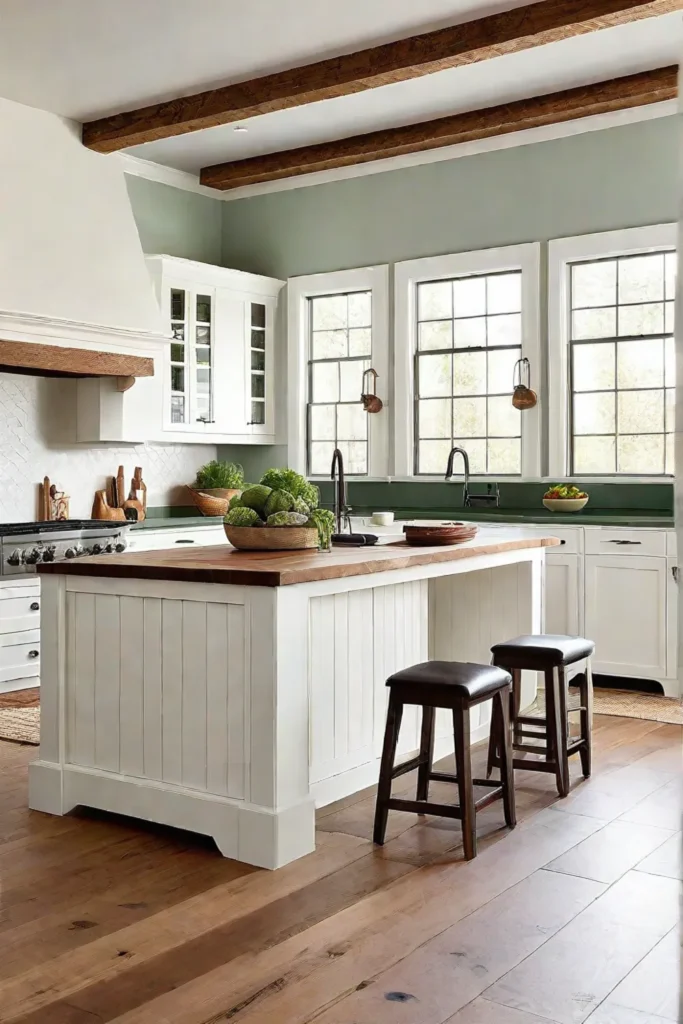
Different wood species and finishes can profoundly impact the overall mood of your kitchen. For instance, the golden hues of oak exude a cozy and inviting vibe, while the deep tones of walnut lend a touch of sophistication. As for reclaimed wood, ethically sourced options from reputable suppliers ensure sustainability and guarantee a one-of-a-kind character that can’t be replicated.
Warm wood tones are the epitome of farmhouse charm. They infuse depth and character into your kitchen while seamlessly blending with the overall color palette. Embrace the beauty of nature and let the warmth of wood envelop your space, creating a truly inviting and welcoming haven.
What could be more delightful than adding a pop of color to your farmhouse kitchen? A vibrancy can breathe new life into this rustic style, injecting personality and charm into your space.
Pops of Color: Adding Personality and Charm
What’s a farmhouse kitchen without a splash of vibrant colors to make it truly inviting? While neutral tones provide a warm and cozy base, pops of accent colors inject personality and visual interest into the space.
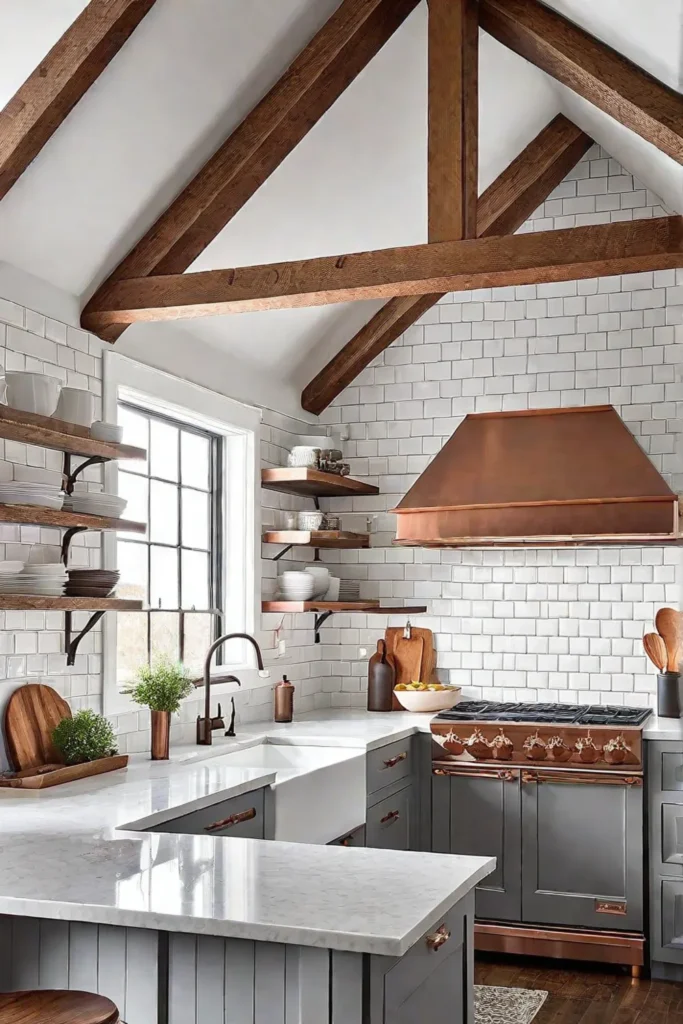
Choosing Accent Colors
The key to introducing accent colors is finding the perfect hues to complement your kitchen’s overall aesthetic. Take inspiration from nature’s palette—the blues of a clear sky, the greens of lush foliage, or the warm terracotta tones of the earth. These colors seamlessly blend into the rustic charm of a farmhouse kitchen.
Creative Applications of Accent Colors
Once you’ve chosen your accent colors, it’s time to get creative with how you incorporate them. Paint is an obvious choice, whether a bold island or a cheerful accent wall. But don’t stop there! Textiles like curtains, rugs, and tea towels offer an easy way to add pops of color. Appliances and kitchen accessories in vibrant hues can also liven up the space.
Unexpected Pops of Color
Who says accent colors have to be limited to the obvious places? Get a little daring and introduce pops of color unexpectedly – like painting the inside of your cabinets or adding a colorful tile backsplash. You could even go bold with a vibrant ceiling or a statement light fixture. The possibilities are endless!
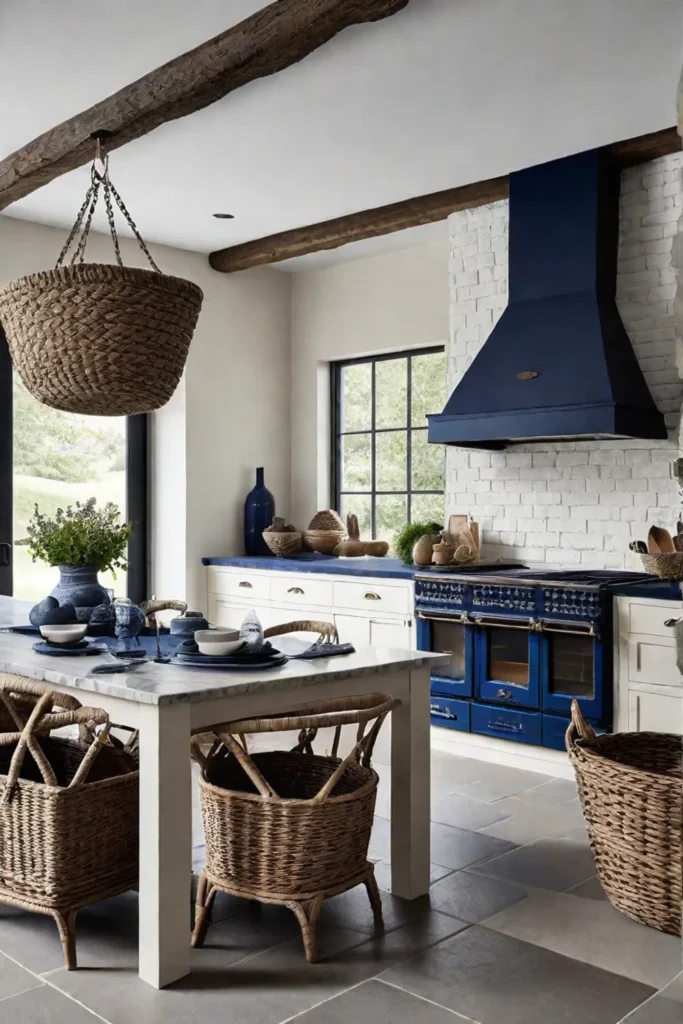
Accent colors have a powerful impact on a kitchen’s perceived size and atmosphere. Warm tones like reds and oranges can make a space feel cozier, while cool blues and greens create a sense of airiness. So, choose wisely based on the vibe you want to cultivate.
A well-balanced color scheme is key to achieving a cohesive and inviting farmhouse kitchen. Use the 60-30-10 rule: 60% dominant color, 30% secondary color, and 10% accent color. With a thoughtful approach, those pops of color will add just the right amount of personality and charm.
Are you looking for a natural way to enhance the rustic appeal of your farmhouse kitchen? Let’s explore the world of natural textures.
Natural Textures: Enhancing the Rustic Appeal
Imagine running your fingers across a stone backsplash’s rough surface or a woven rug’s nubby texture. These tactile experiences make natural textures so captivating in a farmhouse kitchen. They add depth, character, and a rustic charm that instantly makes the space feel more inviting and lived-in.
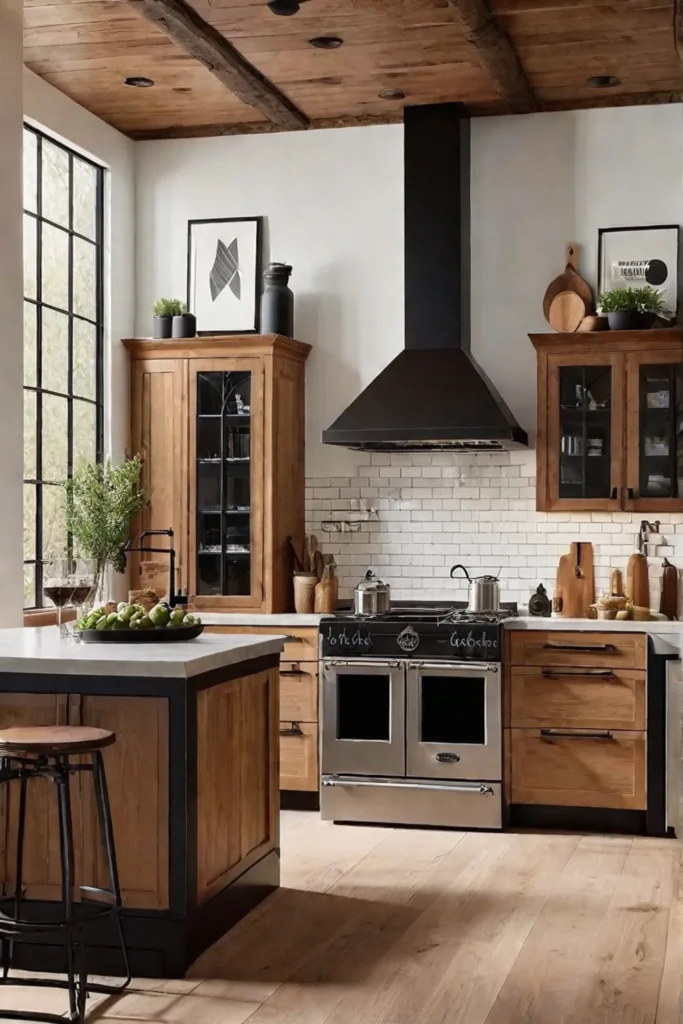
Popular Natural Texture Choices
When it comes to incorporating natural textures into your farmhouse kitchen, the options are endless. Exposed brick walls, reclaimed wood beams, and stone countertops are all classic choices that lend a sense of history and warmth. Consider incorporating woven fabrics like linen curtains, jute rugs, or even a cozy knit throw draped over a chair for a softer touch.
Balancing Smooth and Rough Textures
While natural textures are undoubtedly appealing, balancing rough and smooth surfaces is important. Too many rough textures can create a chaotic, overwhelming space, while too many smooth surfaces feel flat and uninviting. The key is to mix and match textures harmoniously. For example, pair a sleek, modern backsplash with a rustic, distressed wood island for a perfect blend of old and new.
Acoustic and Lighting Considerations
Different textures can also impact the acoustics and lighting in your kitchen. Rough, porous surfaces like brick or stone tend to absorb sound, creating a quieter, more intimate atmosphere. On the other hand, smooth surfaces like tile or glass can amplify noise, making the space feel more lively and energetic. Regarding lighting, rough textures can create interesting shadows and highlights, adding depth and dimension to the space.
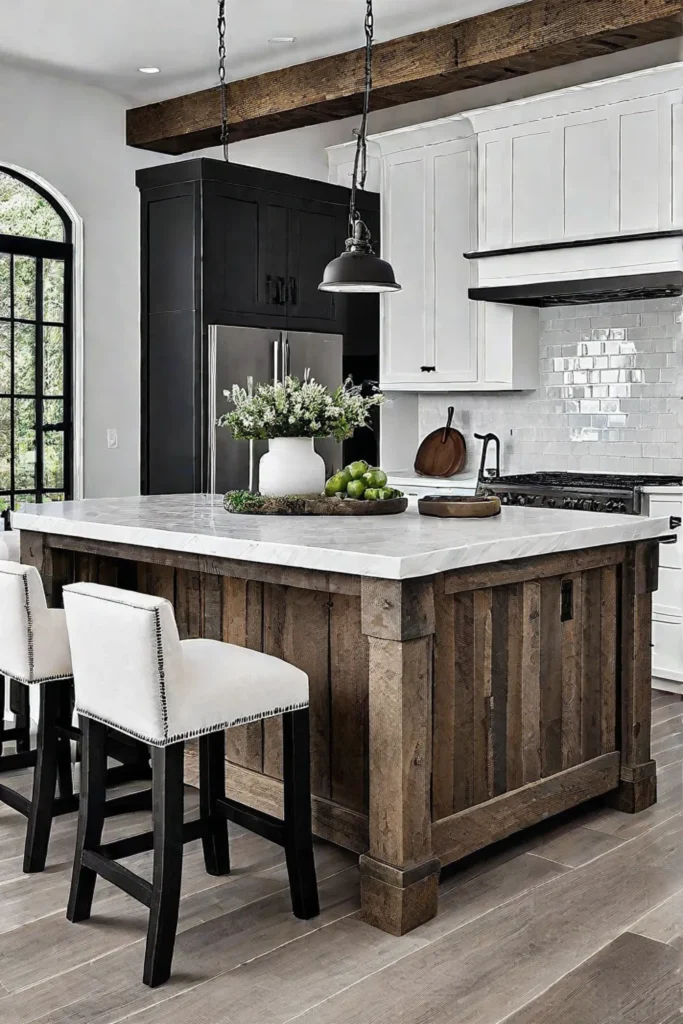
There are plenty of sustainable and eco-friendly options that align with a farmhouse aesthetic. Reclaimed wood, for instance, is rich in texture and environmentally friendly. Natural stone and brick can also be sourced from responsible suppliers, and woven fabrics like linen and jute are often made from renewable resources.
The thoughtful use of natural textures can elevate the warmth and character of a farmhouse kitchen. By embracing a mix of rough and smooth surfaces, you can create a space that feels rustic and refined, inviting and inspiring.
Textures can transform a kitchen from a purely functional space into a warm and welcoming haven. But how do you strike the perfect balance? The next section explores mixing and matching elements for a cohesive, visually stunning farmhouse kitchen.
Conclusion
In the end, a farmhouse kitchen is more than just a collection of elements – it reflects your style and celebrates the simple pleasures in life. By thoughtfully blending neutral hues, warm wood tones, pops of color, and natural textures, you can create a space that feels inviting and inspiring.
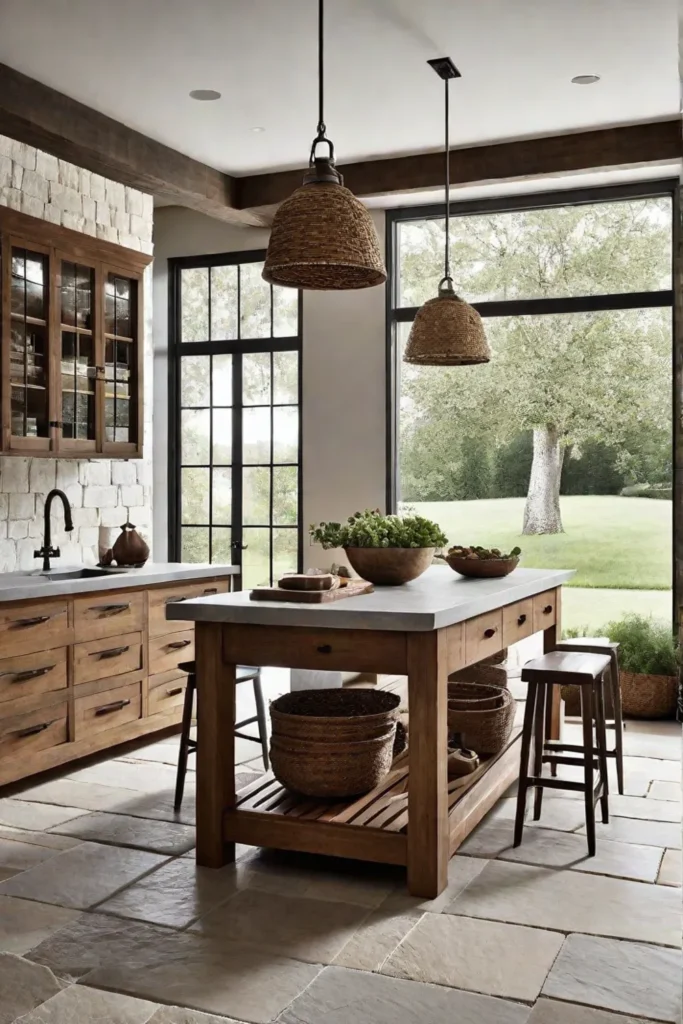
Remember, the true beauty of this beloved style lies in its ability to embrace imperfections and celebrate the beauty of the natural world. So, let your farmhouse kitchen be a canvas for your creativity, a place where you can surround yourself with the things that bring you joy and comfort.
After all, a home is not just a physical structure – it’s a sanctuary where memories are made and cherished. And what better place to start than the heart of your home, the farmhouse kitchen?
